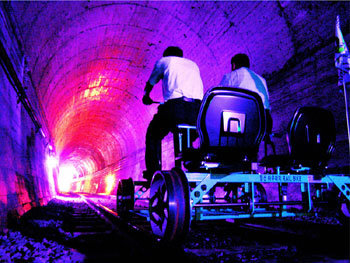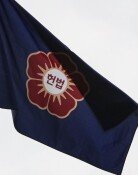Rail-bike Trip at Gujeol-ri

The melody of Arari of Auraji still lingers, but there is no way to find the wooden boat rowed with ropes, much less the boatman. A long time has passed since that boat was secured and the bridge was mounted, but now even the traces of the old bridge have disappeared. Two lovely new bridges cut across that wide waterway Auraji. This is after Hurricane Rusa swept it away.
One of those is the Jeongseon Line (Railroad). It was the exclusive railroad for a small train (with one guest compartment) that leisurely traverses the remote land of Jeongseon to Jeungsan and Gujeol-ri stations. This train was the sole relic that could have accompanied the plaintive music of Jeongseon Arari in abandoned Auraji. Even that vanished at the railway this spring. This is because the 7.2 kilometers of railroad track between the last two stations for the Auraji, Gujeol-ri, and Jeongseon Line were discontinued due to deficits. The small train now runs through the Jeungsan-Auraji block.
No doubt time passes and the world changes. Auraji is not an exception. The reason that is felt sorely is because, subject to the logics of economics, there is sorrow for being dismissed into history in times like these, where finding vestiges of old lang syne is getting increasingly difficult.
June 22, before noon. I sought Jeongseon Railroads terminal, Gujeol-ri Station. Imprisoned by Mt. Nochu, Mt. Okgap, and Mt. Dojang surging like a needlepoint, the sky was even fragmented at the secluded whistle stop station. Keeping the gurgling Songcheon River at my side, the single-track Jeongseon Line stems the current, climbs the slope, and crosses the short span of tunnel to catch its breath and cease its march at this station.
Gujeol-ri Station. This place bears witness to partings. Several times at that. This is where the last Bidulgi Express, Tong-il Express trains trailed off into history. The dingy Bidulgi train that thawed out by the warmth of coal stoves, and the bedraggled Tong-il train where you could catch glimpses of a grandmother who just returned from the market with bundles, carefully folding creased 1,000-won bills in her trousers for her grandsons pocket money, they both said farewells to the railway and passengers at this spot.
Today, however, it was not the farewell station that separated many a loved one. It was the opposite, a meeting station that was embarking on a new era. It is all due to the new owner of Jeongseon Lines Rail-bike that was running on this track, starting at Gujeol-ri.
The rail-bike is a self-propelled vehicle that turns wheels with chains when the pedals are tread. Except for the fact that it travels above the rail and harnesses four wheels, it operates like a bicycle. In addition, the railroad to Auraji is downhill so it is not strenuous. The new vehicle was created thanks to the efforts of residents and the governor of Jeongseon Kim Won-chang to utilize the closed-down railway and protect the Jeongseon Line, which is imbued with the history of the Jeongseon mining town.
I stepped on the pedal of the rail-bike. It wasnt as hard as I thought. It took even less energy than riding a bicycle. Two must pedal, thats why. Entering the tunnel, stark lighting gives off a unique mood. But there is something even more fantastic. The chilly air that belongs to a refrigerator. Its perfect for the heat of midsummer.
The rail-bike runs slowly at 15 kilometers per hour. The scenery that spreads out before you and facing the railroad is breathtaking. Songcheon River never leaves the rail-bikes path after Gujeol-ri. The heat is gone in the cool breeze that brushes the riverbed when crossing the stream. During these godly pleasures, the two tunnels speed by. The rail-bike interval appears around then. It is a small platform that stands on the embankment of Songcheon River. Pictures are taken, river breezes are enjoyed, and thirsts are quenched.
Prior to the terminal station, we cross a looming bridge. This is the Auraji, where the two waters of Imgyecheon River, which lapped at Taebaek, and the Songcheon River, which tailed us from Gujeol-ri, join into one (Joyang River). Glancing to the right river bed in the middle of the bridge, there is a lone stone statue. It is the Auraji maiden who awaits her rafting husband. Moving on, we go into the precincts of Auraji Station. Exactly 40 minutes have passed on my watch.
Can there be a better way to probe into the beautiful flesh of the Jeongseon? The rail-bike tour is a great must-see for this summers travel.
summer@donga.com
Headline News
- Med professors announce intention to leave hospitals starting Thursday
- Bridge honoring Sgt. Moon Jae-sik unveiled in Pennsylvania
- Chief of Staff Chung tells presidential secretaries to stay away from politics
- US FTC bans noncompete agreements
- N. Korea launches cyberattacks on S. Korea's defense companies







